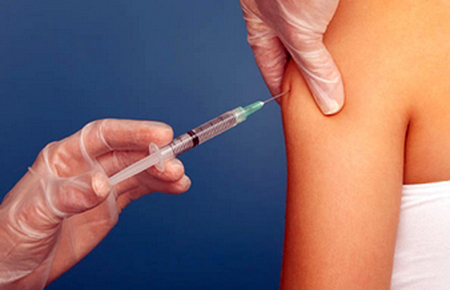What is serum sickness and how is it diagnosed and treated?


Serum sickness is an allergic reaction caused by a high sensitivity of the body to a foreign protein. The disease occurs after the administration of serum made from blood. Allergy occurs as a result of use heterologous (most often equine (horse) material; against tetanus, diphtheria, botulism, gangrene, rabies) and homologous serum for the prevention and treatment of viral hepatitis, measles, tetanus, botulism, etc., as well as vaccines, blood plasma and its components (albumin, γ-globulin ), liver extracts, organopreparations, immunoglobulins, tetanus toxoid for therapeutic and prophylactic purposes, a number of drugs (penicillin, cephalosporins, sulfonamides, a number of anti-tuberculosis drugs, anesthetics, cytopreparations, ACTH, insulin, nonsteroidal anti-inflammatory drugs, cytochromic agents, cytochrome , streptodecase); intake of snake venom, hymenoptera venom into the body. The emergence of the reaction was also noted after administration of monoclonal antibodies for immunotherapy of patients with oncologic diseases.
Short information about serum sickness
Causes and incidence of occurrence
The emergence of serum sickness is associated with:
- Type of serum;
- Dosage;
- Degree of serum purification;
- Frequency of administration.

Previously, the serum sickness was quite common. In the treatment of diphtheria, it was diagnosed in 20–85% of cases, with repeated injections of serum - 96%. However, after the introduction into practice of sera purified from ballast substances, the frequency of serum sickness in different age groups decreased to 1-10%. Reactions to immunoglobulin preparations are even less common, accounting for 0.036–0.06% of cases.
The development of serum sickness is more common in adult patients. The frequency of occurrence sickness is also influenced by the method of administration of the drug causing its development. With its intravenous administration, it develops more often than with intramuscular administration, but it can also develop with intranasal administration of the drug. At the same time, spontaneous sensitization to horse serum is also possible when eating horse meat, inhaling horse dandruff or other components that have an antigenic relationship with its proteins, or when they enter the body by mouth. Fatal outcomes are rare (1 case per 50,000-100,000 serum injections), mainly due to the development of anaphylactic shock.
Symptoms
Serum sickness is more commonly diagnosed and is more severe in adults. The reaction does not occur immediately, but 5-12 days after the administration of the drug. The clinical picture of serum sickness is distinguished by a variety of symptoms and course of the disease, which is due to the difference in the types and titers of the antibodies formed. There are acute, accelerated and chronic forms of serum sickness.

The following symptoms are possible:
- Itchy skin;
- Rash;
- Swelling of the face and body;
- Joint pain;
- Enlarged lymph nodes;
- Temperature rise.
Sometimes abdominal pain, diarrhea, vomiting occur. In some cases, more serious manifestations of the disease are possible in the form of anaphylactic shock, neuritis, damage to internal organs: inflammation of the kidneys (nephritis), inflammation of the heart muscles (myocarditis), etc. Symptoms persist for one to two weeks, after which spontaneous recovery occurs.
Symptoms incidence, details:
- Fever develops in almost 100% of patients;
- Skin changes occur in around 90% of patients, maculo-erythematous, papular, urticarial or measles-like rash is traced, which is often accompanied by itching and is symmetrical; initially appears on the arms, feet and torso , can spread all over the body. After injection of the antigen, the first changes may occur at the injection site. Also found: vasculitis of small vessels, changes resembling polymorphic exudative erythema, erythema of the palms, atypical maculo-nodular changes on the lateral surfaces of the fingers and toes, or a ribbon-like arrangement of these elements along the outer edges of the feet.
- Other symptoms: pain and hypersensitivity to pressure in the joints, swelling and redness in the joints (rare), muscle pain, swollen lymph nodes and spleen, and other symptoms occur in 10–20% of patients.
The rarest but possible manifestation of serum sickness is Guillain – Barré syndrome (acute inflammatory demyelinating polyradiculoneuropathy) with movement disorders, disappearance of tendon reflexes, flaccid paresis, and paralysis. With the widespread course of the process, paralysis of the phrenic nerve occurs with respiratory failure and bulbar disorders. Patients with serum sickness may also experience acute myelitis of the Landry ascending paralysis type.
Types and dangers of serum sickness
- The acute form of serum sickness occurs on the 7-10th day after a single injection of the allergen, that is, without prior sensitization to it. By this time, the patient already has a high level of allergen in the blood and a sufficient titer of antibodies, which determines the formation of immune complexes, their binding of complement, as a result of which the level of the latter in the blood falls.
- Accelerated serum sickness results from repeated administration of a causative allergen. In such situations, the manifestations of serum sickness are much more pronounced and may be accompanied by the development of anaphylactic shock and other signs of atopy.
- Chronic serum sickness occurs with repeated daily injections of a foreign protein in the case when injections of an allergen lead to its excess, persistence in the body and circulation of immune complexes with a subsequent weakening of antitelogenesis, which is accompanied by a decrease in immune complexes solubility and damage to the vascular walls. In the development of chronic serum sickness, the pathology of the complement system and its individual fragments may be important. Chronic serum sickness is characterized by the development of systemic arteritis (inflammation of the arteries) with involvement of venules (small blood vessels) in the process.
According to the intensity of clinical manifestations, serum sickness is divided into 4 forms:
- Mild;
- Moderate;
- Severe;
- Anaphylactic.
A mild form of serum sickness occurs in about half of patients. The general condition of the patient remains with an increase in body temperature to 38 C (100.4 F). There is an urticarial or other type of rash, angioedema (swelling), a slight and short (within 2-3 days) enlargement of the lymph nodes. Joint pain is relatively rare.

The moderate form of serum sickness is characterized by itching, burning, soreness, swelling and hyperemia of the area of the allergen injection site, a moderate increase in regional lymph nodes, and urticarial skin rashes. At the same time, the patient suffers from headache, sweating, tachycardia, hypotension, joint ache, nausea and vomiting. The body temperature reaches 38–39 C (100.4- 102.2 F) and persists for 1–2 weeks. Moderate leukocytosis (leukocyte count above the norm) with a tendency to subsequent leukopenia (low white blood cell count) with relative lymphocytosis (a higher-than-normal amount of lymphocytes) and eosinophilia (too many eosinophils), increased ESR is noted in the blood. The urine shows traces of protein. The duration of this state is from 5-7 days to 2-3 weeks.
The severe form of serum sickness differs from the previous ones by a short incubation (symptomless) period, an acute onset, the appearance of widespread measles-like or hemorrhagic rashes, hyperemia of the pharynx and conjunctiva, more pronounced nausea, vomiting, diarrhea, pain in the joints and along the nerves, the development of synovitis and a significant increase in neuralgia, soreness of the lymph nodes, high (up to 39-40 ° C or 102.2- 104 F) and prolonged fever, frequent relapses, more pronounced tachycardia, hypotension, shortness of breath. In the blood of patients, there is leukopenia with relative lymphocytosis, thrombocytopenia, increased ESR, decreased coagulation.
The anaphylactic form of serum sickness most often occurs with repeated intravenous administration of serum during or immediately after injection. Clinically, it is manifested by a sudden stunning of the patient, a decrease in blood pressure and an increase in body temperature. Later, stunning is replaced by agitation, convulsions appear, spontaneous discharge of urine and feces, albuminuria, shortness of breath, cyanosis develop, and death can occur. Fortunately, this form of the disease is rare.
Possible severe complications of serum sickness are myocarditis, endocarditis, exudative pericarditis, nephritis, hepatitis, allergic encephalitis, meningitis, polyneuritis, diffuse connective tissue damage, respiratory damage (acute pulmonary edema, pulmonary eosinophilia, laryngeal edema, bronchodilator) necrosis of the skin and subcutaneous tissue at the injection site of the causative allergen.
Diagnostics

The diagnosis is made on the basis of information about the administration of protein preparations, as well as the clinical picture of the development of an allergic reaction characteristic of the disease.
For a correct diagnosis the following must be done:
- General examination of the patient;
- Collecting anamnesis (history of the disease, use of medicines, vaccines, serums);
- Blood test (general and biochemical);
- General urine analysis;
- Taking allergic samples;
- Ultrasound of internal organs, as well as X-rays to detect damage.
What tests can show? Diagnostic criteria
- The diagnosis is made on the basis of subjective and objective symptoms that appeared due to confirmed or possible exposure to provoking factors.
- Differential diagnosis (exclusion of other potential causes of the symptoms). Mainly it is made to exclude a rash of a viral nature, inflammatory diseases of the joints (including rheumatic fever), polymyositis or dermatomyositis, polymorphic exudative erythema, angioedema, systemic vasculitis.
Treatment

Treatment of serum sickness is mostly symptomatic. It depends on the form of the disease and includes the elimination of the causative allergen, as well as the use of drugs aimed at relieving the symptoms of the disease. With mild to moderate severity of the disease, non-sedating antihistamines of the second generation (cetirizine, loratadine) or their active metabolites (desloratadine, fexofenadine, levocetirizine) are used inside.
In case of severe course of serum sickness, antihistamines of the 1st generation (clemastine, chloropyramine) and systemic corticosteroids (prednisolone, methylprednisolone, dexamethasone) are used in injections and/or orally.
Doses of corticosteroids and the duration of their intake are determined by the severity of the disease. Usually, corticosteroids are prescribed for 6–8 days at a dose of up to 30–40 mg/day with a rapid subsequent decrease. In the case of a predominance of itchy skin lesions, non-sedating antihistamines of the second generation or their active metabolites orally are recommended. Acetylsalicylic acid, anticoagulants, serotonin antagonists (cyproheptadine), sedatives and tranquilizers also have a positive effect. Plaquenil can be effective in some cases.
For severe articular lesions, non-steroidal anti-inflammatory drugs are used, and for edematous syndrome, diuretics are used. In the case of the anaphylactic form of serum sickness, treatment tactics are determined in accordance with its severity.
Prevention
If the use of a medicine that could cause serum sickness in a patient is unavoidable, an antihistamine and corticosteroids for systemic use should be prescribed at the same time.
Post by: Natalie Keller, M.D. General Health Centre, Minneapolis, Minnesota
(Updated at Apr 13 / 2024)
Periactin articles:
Some of the trademarks used in this Web Site appear for identification purposes only.
All orders are reviewed by a licensed physician and pharmacist before being dispensed and shipped.
The statements contained herein are not intended to diagnose, treat, cure or prevent disease. The statements are for informational purposes only and is it not meant to replace the services or recommendations of a physician or qualified health care practitioner. If you have questions about the drugs you are taking, check with your doctor, nurse, or pharmacist.